
* The German branch of the Airbus Helicopter line began with a light helicopter designed by the Boelkow firm, which emerged as the "Bo 105". It proved very popular in both civil and military service, and still remains in extensive use today. It was replaced by an improved follow-on, originally the Eurocopter "EC135", now the "Airbus H135".
* In 1948, Ludwig Boelkow opened a civil engineering office in Stuttgart, Germany; in 1956, Boelkow moved into aviation work with the formation of the company Boelkow-Entwicklungen KG, with the company head office moving to Ottobrunn, near Munich, in 1958.
In 1957, Boelkow-Entwicklungen worked with a team of helicopter experts -- known as the "German Helicopter Study Group (DSH in its German acronym)" and headed by Dr. D.W. Just -- on the development of a helicopter trainer. A prototype was built as the "P102" and was praised by students running it through its paces, resulting in the production "Bo 102", introduced in 1959. It was one of the more eccentric rotorcraft ever manufactured, a single-seat nonflying helicopter trainer that was similar to a carnival ride. It had a 30 kW (40 HP) piston engine and a rotor system with Hiller-type control paddles with a half-blade main rotor, the other half being counterweighted; it rode on a pivoting arm mounted on a four-legged stand. It looked like it was fun to play with, though not necessarily something "real men" would have been happy to climb into; it did certainly prove useful, and the company did a fair business with the Bo 102, selling it to several European nations.
Of course, Boelkow-Entwicklungen wanted to build a helicopter that actually flew as well, leading to the first flight of the "Bo 103" on 14 September 1961. The Bo 103, designed by Hans Derschmidt, was effectively an airworthy version of the Bo 102, with landing skids instead of a stand and twice the engine power; it still had the half-blade / counterweighted main rotor and surprisingly flew perfectly well. It was strictly a demonstrator, never got out of the prototype phase, and it seems only one was built.
In the same year, 1961, Boelkow-Entwicklungen began work on two new helicopters, the "Bo 46" and the "Bo 105". The Bo 46 was a demonstrator for an advanced five-blade "rigid rotor" scheme invented by Derschmidt. Three were built for the German Ministry of Defense, with the first flying in 1964, but the design proved overly complicated and was not put into production. The Bo 105 proved more the way of the future, though it wasn't obvious that the company had a winner at the outset.
* The Bo 105 was conceived as a light helicopter with five or six seats, powered by twin turboshaft engines, featuring an innovative unarticulated rigid rotor system invented by Professor E. Weiland, with the rotor scheme evaluated in a collaboration with Sud-Aviation of France on an Alouette II helicopter.
The initial Bo 105 prototype -- designated the "V1", where "V" stood for "Versuchs (Prototype)" -- was powered by twin Allison 250-C18 turboshafts. It did not feature the new rotor system, instead using a conventional rotor system taken from a British Westland Scout helicopter. The V1 machine came to a bad end even before taking to the air, being wrecked during ground testing in 1965. The V2, the second prototype, featured the rigid rotor along with the Allison engines and performed its first flight on 16 February 1967, with Wilfried von Engelhard at the controls. By that time the company was known as "Boelkow GMBH", thanks to a reorganization following an infusion of cash from US aerospace giant Boeing.
A third prototype, the V3, was built, featuring MAN-Turbo 6022 engines, with initial flight on 20 December 1967. Two preproduction machines, the V4 and V5, were flown in 1969, with initial deliveries of the first production machines, designated "Bo 105C", late in the year. By that time the company had evolved again, having merged with Messerschmitt in 1968 to become "Messerschmitt-Boelkow GMBH" -- and then merged again with Hamburger Flugzeugbau GMBH, an offshoot of the Blohm und Voss firm, to become "Messerschmitt-Boelkow-Blohm (MBB)" in 1969.
BACK_TO_TOP* The initial Bo 105C variant provides a baseline for the series. It was utilitarian in appearance, with an egg-shaped body, twin landing skids, twin engines driving the four-blade rotor on top, and a tailboom with a twin-blade rotor and two rectangular tailfins mounted high on the rear. Few would have thought it particularly sexy in appearance, but it was businesslike; its successors would have much the same unadorned style.
Production machines were powered by twin Allison 250-C20 turboshafts providing 300 kW (400 SHP) each; the Allison 250-C18 and MAN-Turbo 6022 were offered as options early on, but nobody bought them. The folding four-blade main rotor was made of fiberglass and had a titanium hub; the tail rotor was also made of fiberglass. A rotor brake was standard. The rotor system provided considerable agility, including the ability to perform loops.
Accommodations included a pilot and passenger seat up front -- dual controls could be installed for training -- and a seat for three across in the back. In an alternate configuration, two stretchers could be carried, along with two medical attendants. There was a hinged door forward and a sliding door towards the back on each side of the fuselage; there were clamshell cargo doors in the rear. The landing skids could be fitted with four inflatable emergency flotation devices, or pontoons could be fitted in place of the skids. Other optional kit included a rescue winch mounted above the door and a cargo sling hook.
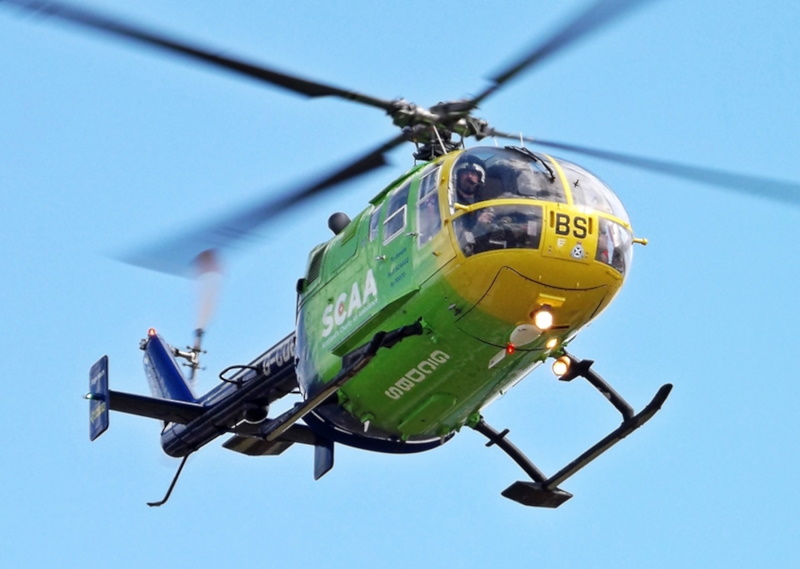
A variant designated the "Bo 105D" was produced for sale in Britain, being generally identical to the Bo 105C except for some minor differences as per UK Civil Aviation Authority (CAA) requirements. From 1975, production moved to the "Bo 105CB", which was generally the same as the Bo 105C except for uprated Allison 250-C20B turboshafts, along with an improved rotor system to handle the higher power ratings.
___________________________________________________________________
MBB BO 105CB:
___________________________________________________________________
main rotor diameter:
9.84 meters (32 feet 4 inches)
tail rotor diameter:
1.9 meters (6 feet 3 inches)
fuselage length:
8.56 meters (28 feet 1 inch)
footprint length:
11.86 meters (38 feet 11 inches)
height (rotor head):
3 meters (9 feet 10 inches)
empty weight:
1,276 kilograms (2,813 pounds)
max loaded weight:
2,500 kilograms (5,510 pounds)
maximum cruise speed:
240 KPH (150 MPH / 130 KT)
service ceiling:
5,180 meters (17,000 feet)
range:
575 kilometers (360 MI / 310 NMI)
___________________________________________________________________
The Bo 105CB led to a slightly "stretched" version, the "Bo 105CBS", with the fuselage extended by 25 centimeters (10 inches) to a length of 8.81 meters (28 feet 11 inches), permitting up to six passengers. It could be distinguished from "short" variants by a small additional side window at the rear of each side of the passenger compartment. A UK-spec version was sold, designated the "Bo 105DBS"; the Bo 105CBS was also marketed in the USA as the "Twin Jet II". The Bo 105CBS was sold in refined production blocks up to the "Bo 105CBS-4" and its stablemate, the "Super 5", which incorporated refinements developed for military variants of the Bo 105.
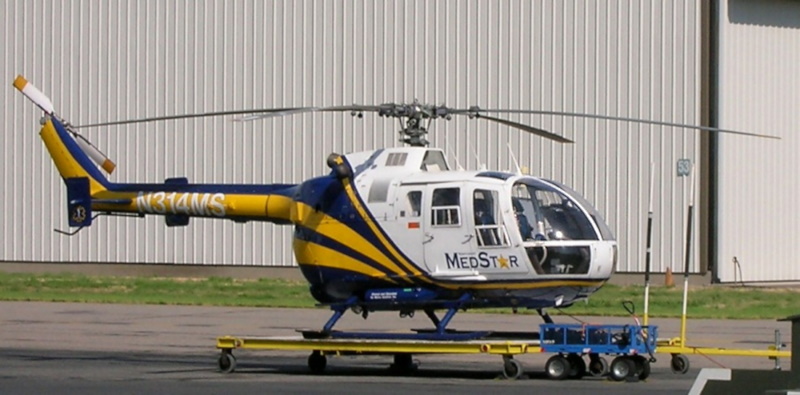
In the early 1980s, a variant of the stretched Bo 105CBS designated the "Bo 105LS" was introduced that featured still more powerful Allison 250-C28C turboshafts with 375 kW (500 SHP) take-off power each and an uprated rotor transmission to handle the greater power. It was only built by MBB Canada. As with the Bo 105CBS series, the Bo 105LS was sold in production blocks, up to the "Bo 105LSA-3", which was sold along with a "flying crane" subvariant, the "Bo 105LSA-3 Super Lifter".
IPTN / Dirgantara of Indonesia assembled both the Bo 105CB and Bo 105CBS for local sale, with locally-assembled machines designated the "NBO-105CB" and "NBO-105CBS" respectively. At least 121 machines were built there. Some sources mention a production deal for the Bo 105 in the Philippines, but if it happened details are hard to find.
BACK_TO_TOP* The Bo 105 proved popular as a military helicopter, generally in the utility role, but with a good number built in combat configurations. The biggest military user was the West German Army, which bought both scout and anti-armor variants:
The evolution of the German Army Bo 105s is a somewhat confusing subject. Upgrades were implemented for the PAH-1 early on, with an AN/APR-39 radar warning receiver (RWR) fitted from the mid-1980s. That led to a more thorough upgrade in the early 1990s, featuring a new digital sighting system for the HOT missiles; a new lightweight launch rack arrangement for the HOTs; a modified engine installation; and an updated main rotor, with rounded-off tips. All surviving PAH-1s were upgraded and redesignated "PAH-1A1". It was simple to tell the two variants apart: the HOT launch tubes of the PAH-1 were arranged in a row straight out to the sides of the helicopter, while the launch tubes of the PAH-1A1 were mounted on a rack angling down from each side.

The VBH fleet was retired, since the machines were heavily utilized and had reached the end of airframe life. The PAH-1A1 has been replaced by the Airbus Tiger gunship helicopter; the PAH-1A1s had not been so heavily utilized, so some of them were stripped of armament and refitted for the VBH role.
To confuse the topic further, several combat variants of the Bo 105 were proposed for German service, but not actually obtained:
* The Spanish Army acquired 60 military Bo 105CBs in 1979, with 57 assembled by CASA in Spain from knockdown kits provided by MBB. They included:
The HA.15 anti-tank machines were never upgraded to a spec comparable to the PAH-1A1. They have been replaced by the Airbus Tiger. The armed HR.15 scout machines were retired early in the 21st century, having gone beyond their safe airframe life. The unarmed HR.15 scout machines have been phased out, with some passed on to civil security forces; the EC 135, discussed below, was obtained as a replacement. Incidentally, CASA also assembled a batch of Bo 105s for Iraq.
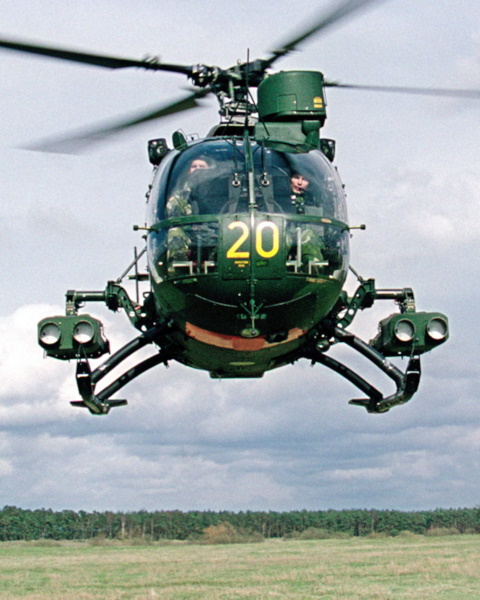
* In 1987, the Swedish Army ordered 20 Bo 105CB machines in an anti-armor configuration, carrying four TOW antitank missiles on pylons, with a SAAB HeliTOW night-capable sight on the cockpit above the pilot position. They were fitted with cable cutter blades as well. The Swedes designated the machine the "HKP 9A", where "HKP" stood for "helicopter". The Swedish Air Force also obtained four "stretched" Bo 105CBS machines for SAR operations, designating them "HKP 9B".
* The Mexican Navy obtained 12 Bo 105CBs in a navalized configuration, with Sperry Primus 500 radar in the nose, doppler radar under the tail boom, rescue hoist, folding rotor blades, flotation kit, and facilities for lashing the machines to the deck of a naval vessel. It does not appear that they were armed; they were used in the utility / SAR role. Colombia acquired a number of Bo 105s to a similar spec.
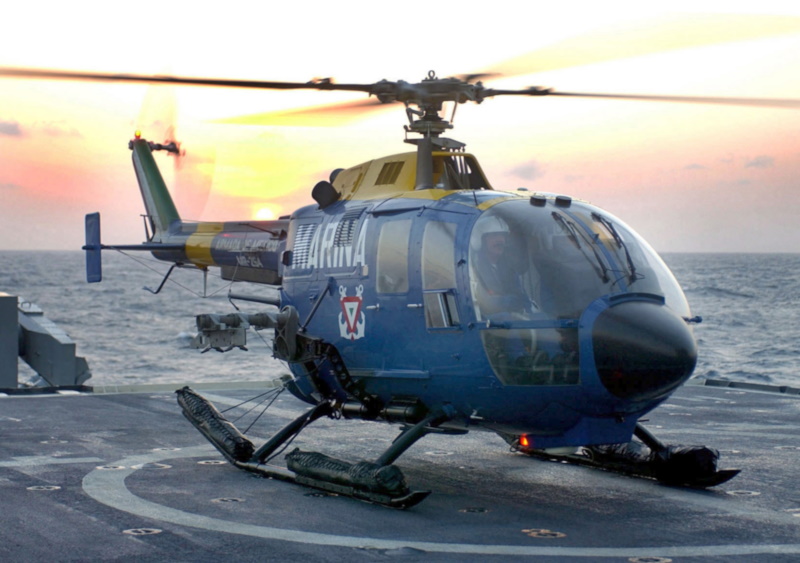
While the Bo 105 series was popular with world military arms, it is unclear just how many services other than those listed above obtained variants with combat optimizations instead of in the "plain" utility configuration. Photos exist of a Bo 105CBS with stores pylons, cannon and rocket pod warloads, and a spherical roof-mounted sight; or with a roof-mounted sight along the lines of that of the Swedish HKP 9A, and carrying four Hellfire anti-armor missiles on pylons. These machines appear to have been demonstrators, however, and there's little evidence that anybody bought them.
BACK_TO_TOP* Production of the Bo 105 series ended in 2001, after delivery of over 1,400 helicopters to over 40 countries. The Bo 105 was obsoleted because a better replacement was available. In the late 1980s, MBB had begun work on a follow-on to the Bo 105, essentially performing a "clean sheet" reconsideration of the design. The initial flight of a technology demonstrator, designated the "Bo 108", was on 15 October 1988. It had the same general arrangement as the Bo 105, but featured better streamlining; like most Bo 105s, it was powered by two Rolls-Allison 250-C20R turboshafts. A second prototype, with twin Turbomeca Arrius turboshafts, performed its initial flight on 5 June 1991.
In late 1992, work began on a significant redesign of the Bo 108, one objective being to increase passenger capacity. By this time MBB had, though a series of acquisitions and mergers, become part of the Eurocopter company, effectively joining MBB with the helicopter division of Aerospatiale of France. Further changes were in store: Eurocopter would later become a segment of the giant European Aerospace & Defense Systems (EADS) conglomerate, which became in turn the Airbus Group at the beginning of 2014 -- Eurocopter becoming Airbus Helicopter. The Airbus name is used here for simplicity.
Not coincidentally, the redesigned Bo 108 featured the enclosed "fenestron" tail fan rotor, a trademark of many Aerospatiale helicopters; the merger between the German and French helicopter companies would lead to an interesting as well as somewhat confusing technological cross-breeding between their product lines. The fenestron configuration was quieter, more efficient, and the rotor being screened off, also improved safety to a degree, the tail rotor being a traditional lethal hazard to the careless in helicopter operations.
Three preproduction prototypes of the "EC135", as it was known, were built. The first performed its initial flight on 15 February 1994; it was powered by twin Turbomeca Arrius 1B turboshafts. The second prototype, powered by twin Pratt & Whitney Canada (PWC) PW206B turboshafts, performed its initial flight on 16 April 1994; and was followed by the third prototype on 28 November 1994, this machine reverting to the Arrius 2B powerplant. Certifications were awarded from 1996, with the type going into production in that year.
* The EC135 followed the traditional MBB helicopter layout, aside from the French-inspired 10-blade fenestron tail rotor. It had the pod and boom configuration; a four-blade composite main rotor, though made of graphite epoxy instead of fiberglass; twin (swept) tailfins; clamshell rear doors; and skid landing gear. However, it featured an airframe made mostly of composite materials, as well as a "glass cockpit" with twin flat panel displays. The improved aerodynamics of the EC135 made it substantially less "draggy" than the Bo 105, and overall the EC135 was advertised as 25% cheaper to operate.
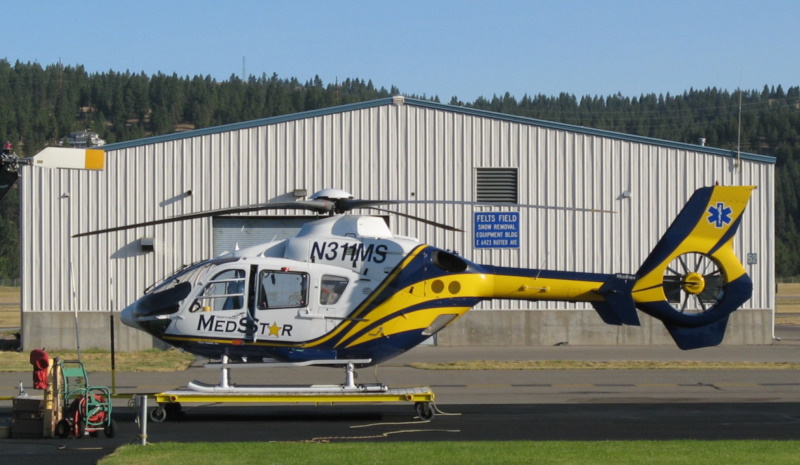
There were seven seats in the normal transport version, including seats for one or two pilots, with forward-hinged doors on each side for the pilots and sliding doors on each side for the passengers. Typical air ambulance configuration was a pilot, two stretchers, and two medical attendants. Optional kit included a cargo sling hook, rescue winch, inflatable flotation gear, loudspeakers, searchlight, day and night video imagers, and a weather radar in a pimple nose radome.
___________________________________________________________________
EUROCOPTER EC135:
___________________________________________________________________
main rotor diameter:
10.2 meters (33 feet 6 inches)
fenestron fan diameter:
1.0 meter (3 feet 3 inches)
fuselage length:
10.2 meters (33 feet 6 inches)
footprint length:
12.16 meters (39 feet 11 inches)
height (tailfin):
3.51 meters (11 feet 6 inches)
height (rotor head):
3.35 meters (11 feet)
empty weight:
1,495 kilograms (3,284 pounds)
max loaded weight:
2,900 kilograms (6,393 pounds)
maximum cruise speed:
255 KPH (160 MPH / 135 KT)
service ceiling:
3,050 meters (10,000 feet)
range:
630 kilometers (390 MI / 340 NMI)
___________________________________________________________________
Production has run through a series of variants:
Special EC135 fits for police, VIP transport, and other applications have been offered. The type is used for training, sometimes being given the military service designation of "TH-135". The EC135 proved popular with civil and government users, with license assembly deals in Romania, Spain, and Switzerland. The EC135T2+ was adopted by Australia for the country's joint training service.
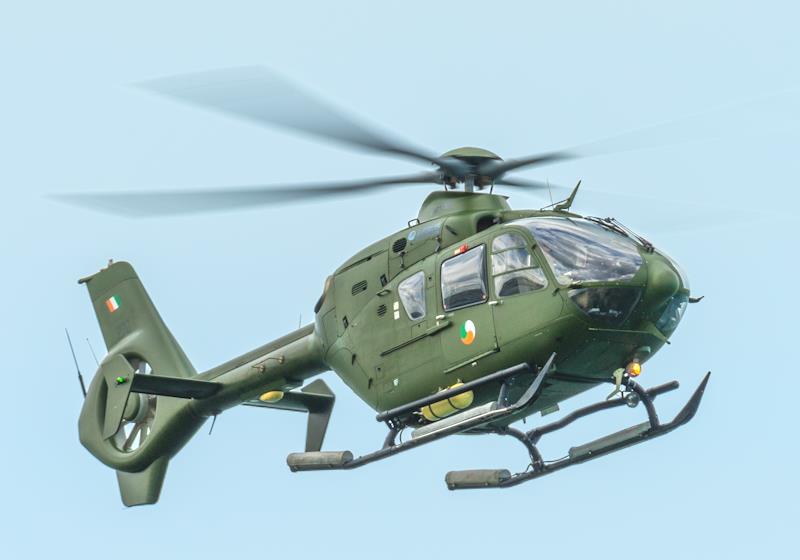
One EC135 was configured for trials as the "Active Control Technology / Flying Helicopter Simulator (EC135 ACT/FHS)", performing its first flight in 1999. One of the EC135 prototypes was modified as an "eco-demonstrator" named the "Bluecopter" to test advanced technologies for reducing fuel consumption, with the machine performing initial flights in the new configuration from 2015. It featured a new five-blade rotor and tailfan, plus other tweaks. Early trials demonstrated fuel burn improvements of 12% to 15%.
In 2015, the EC135 was redesignated "H135", though earlier variants were not retroactively redesignated, still being known as "EC135". Increased gross weight and single-pilot / IFR options were introduced in 2020. That same year, the US National Aeronautics & Space Administration obtained three H135s for support operations at Kennedy Space Flight Center in Florida -- a small but high-profile sale. Three years later, the H145 was obtained by the Spanish Air Force, primarily for training.
A combat variant, the "EC635", was offered from early on. It featured militarizations such as stores pylons, sighting systems, and cable cutters. An initial contract for the EC635 with the Portuguese Army fell through; the Jordanian Army became the launch customer, ordering a total of 13, with deliveries from the first batch beginning in 2003. Switzerland was the second customer, obtaining a total of 18, with Iraq ordering 24 in 2009. In 2015, the EC635 was redesignated "H135M". As of early 2021, more than 1,400 EC135 / H135 helicopters had been built.
BACK_TO_TOP